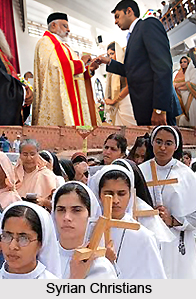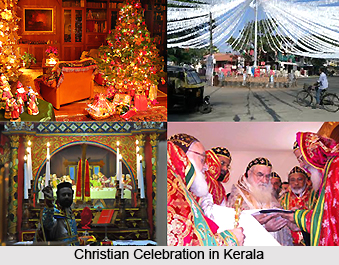 Christians of Kerala form a major bulk of population in the state. There is, however, no clear evidence of the arrival of Christianity in Kerala. The Jews and the Christians arrived in this South Indian state latest by the early second century A.D. The Christian strongholds are in the former princely states. In Cochin, a considerable amount of people are Christians; around Kottayam in Travancore, which is the Rome of the Syrian Christians and the seat of their leader, the Catholics of the East, they actually outnumber the Hindus. The Christian strength represents a series of conversions corresponding to various phases of trading activity. The Syrian Orthodox Church, which - with its various schisms - forms the largest and most interesting group of Christians in Kerala, dates from the era of Alexandrian trade and claims to have been reinforced by waves of immigrants who came from Mesopotamia and Persia under the leadership of Christian merchants.
Christians of Kerala form a major bulk of population in the state. There is, however, no clear evidence of the arrival of Christianity in Kerala. The Jews and the Christians arrived in this South Indian state latest by the early second century A.D. The Christian strongholds are in the former princely states. In Cochin, a considerable amount of people are Christians; around Kottayam in Travancore, which is the Rome of the Syrian Christians and the seat of their leader, the Catholics of the East, they actually outnumber the Hindus. The Christian strength represents a series of conversions corresponding to various phases of trading activity. The Syrian Orthodox Church, which - with its various schisms - forms the largest and most interesting group of Christians in Kerala, dates from the era of Alexandrian trade and claims to have been reinforced by waves of immigrants who came from Mesopotamia and Persia under the leadership of Christian merchants.
The Roman Catholics arrived under the aegis of the Portuguese state-controlled trading enterprise, with its centre at Fort Cochin; apart from an attempt to take over the Syrian Church, this era was marked by the spectacular mission of Francis Xavier among the low-caste fishermen of Travancore which laid the foundations of a flourishing Latin Catholic Church. Finally, after the British East India Company established its dominance, the Protestants of the Church Missionary Society arrived in Travancore and the Lutherans of the Basel Mission began work in Malabar. A far-reaching reformation within the Syrian Church emerged from the work of the Church Missionary Society, which also laid the foundations for the Anglican-dominated Church of South India.
The Christians and Muslims worked to such effect that today a significant number of the population of Kerala follows one or other of the Middle Eastern creeds. No Keralan government has yet stayed in power without the support of either Christians or Muslims in Kerala. The role of Christianity in shaping the special character of Kerala has gone far beyond its success in making converts. It was mainly by the efforts and influence of the nineteenth century Protestant Christians that modern, western-style education was introduced into Kerala.
A tiny minority of the muslims in Kerala are of Arab descent, and the small groups of Christians who came from Persia and Mesopotamia were so quickly absorbed that their modern co-religionists look very much like other Keralans; indeed, it is a sign of their predominantly native origin that they still preserve among themselves the division between high-caste Syrian Christians, claiming Nayar and Namboodiri descent, and Latin Christians of the lowly fishermen castes, probably descended largely from the pre-Dravidians.
 The incursions of foreign influence which turned a majority of Malayalis into Christians and Muslims were cultural in their effect, but not racial; they left the make up of the Malayali people as it was established by the beginning of the Christian era; since that time there have been no great migrations and hence no major changes.
The incursions of foreign influence which turned a majority of Malayalis into Christians and Muslims were cultural in their effect, but not racial; they left the make up of the Malayali people as it was established by the beginning of the Christian era; since that time there have been no great migrations and hence no major changes.
In A.D. 52, St. Thomas, Doubting Thomas of the New Testament, is said to have landed at the Keralan port of Muziris and started his task of conversion. From this date, all Indian Christians believe, their Church began and has continued without interruption. The tradition is supported only by other traditions; there is no contemporary evidence which bears upon the arrival of the first Christian teacher. Yet the traditions are numerous and insistent enough to induce in anyone who examines them a strong subjective tendency towards acceptance.
Legend of St. Thomas
St. Thomas, as per legend, preached the gospel at Muziris with great patience, waiting eight months before he was able to form his first congregation. Then, while living in the Jewish quarter of the city, he is said to have converted the local Raja, together with four hundred Hindus and forty Jews. Later he founded seven churches, at Cranganore, Quilon, Parur, Palur and other places on the coast of Kerala where the Christian community is undoubtedly very ancient. Eventually he departed, for Chennai (Madras), and preached on the Coromandel Coast, until he was slain by hostile Hindus and buried on the site of the present cathedral of Mylapore.
There are certain non-Christian traditions which bear at least obliquely on this account. The Syrian Christians, the members of the church St. Thomas is said to have founded, regard themselves as superior to all other Christians, and base their claim to high social standing on the legend that many of St. Thomas`s converts were of high caste, either Namboodiri Brahmins or Nayars; this claim is unexpectedly supported by an anti-Christian tradition of the Brahmins themselves, recorded in the Keralol-patti, according to which a certain `Thoman`, who was `an opponent of ail Vedas`, came to Malabar and converted `many prominent people in the land`, including the reigning king, Bana Peramal. Jewish traditions in Cochin also support the Christian legend, first by repeating the account of the arrival of St. Thomas and secondly by claiming the existence of a Jewish colony at Muziris, though the date they usually give for their own arrival is A.D. 69, some seventeen years after the traditional date of St. Thomas`s landing. As for the story of St. Thomas itself, it is so ancient and so strongly held by the Indian Christians that it cannot be lightly dismissed, and certain aspects contain at least good circumstantial evidence.
It is difficult to deny the truth of the account Syrian Christian community of the conversions by St. Thomas on the Malabar Coast. Even if the evidence for Thomas`s actual arrival in Kerala is never likely to be conclusive, it is evident that Christian missionaries did make their way to Kerala not much later than the beginning of the 2nd century A.D., and it is probable that they arrived by a Greek ship sailing from Alexandria to Muziris. Cranganore (Muziris) must therefore in any case have been the point at which Christianity first touched the Malabar Coast.



















